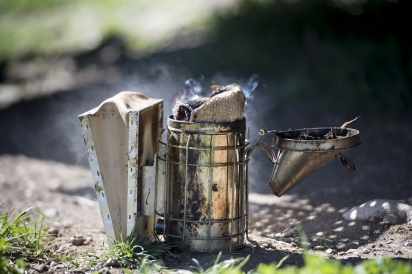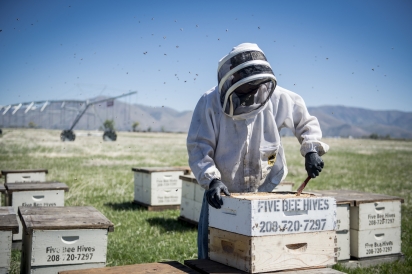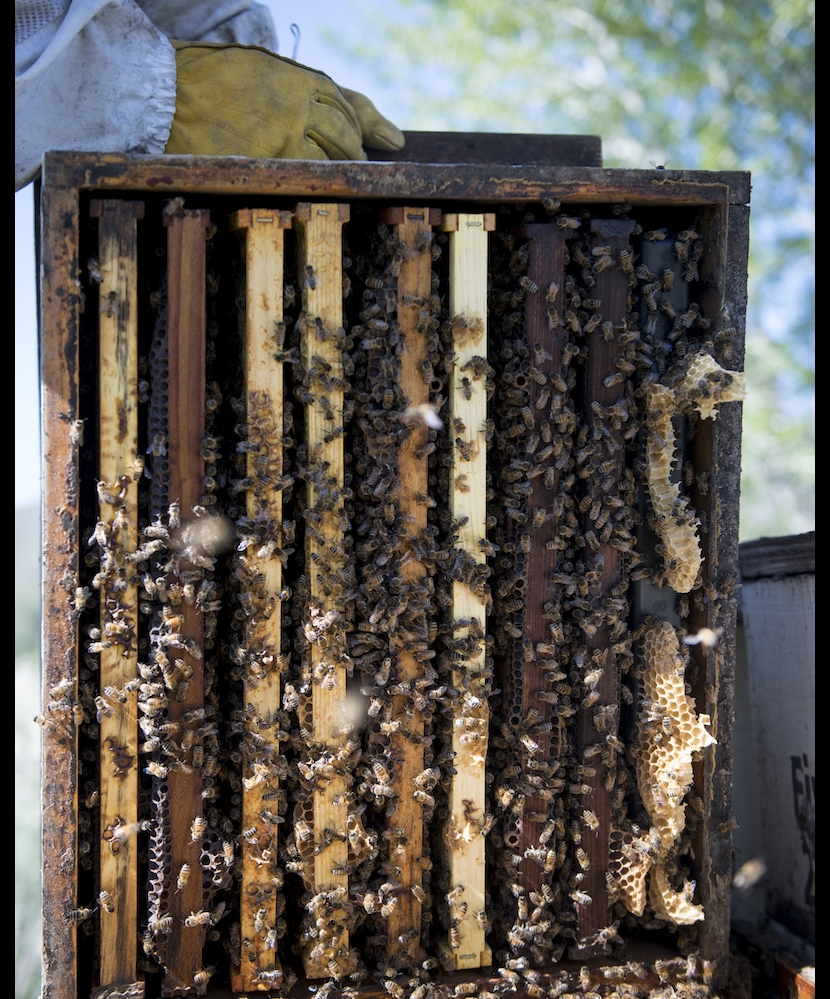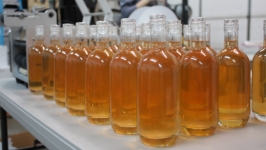Honey's Bittersweet Challenges
In a matter of spending just two hours with Five Bee Hives’ Tom Harned, it feels like I’ve taken an entire crash course on everything related to bees, hives and pollinators. A beekeeper for 10 years and a resident of the Wood River Valley for 20, Harned provides fresh local honey to restaurants and stores in Ketchum, Hailey and Bellevue. While the beekeeping and honey business still provides enough for his livelihood, times are getting tougher for pollinators, including the honeybees necessary for Harned’s business.
“We all lose bees, it’s part of the game,” he says. “The question is how many are you going to lose. In the good old days, if you had 100 hives, you would go out after winter and find one dead. You go out there now, you’ll find 20–70 dead, the majority. This year I had 55% loss. So out of 900 hives, I was down to 400 after winter.
To blame for Harned’s and all other American beekeepers’ losses is the Varroa mite, a native of Asia that made its way to the United States in the 1980s. European honeybees, which are used for honey production in the U.S., have never learned to live with the mites like their Asian counterparts, meaning that beekeepers must constantly fight to keep mite numbers down in their hives. This means treating with pesticides, using queens with more hygienic stock (at the risk of producing less honey) or using a variety of natural methods.
Harned manages to bounce his numbers back each year but has his own theory of what it would take to truly help the honeybee.
“Hives are becoming more and more important because the native population is gone,” Harned says. “There’s something to be said for the argument that these bees are an invasive species and taking resources away from native pollinators. But as far as the world we live in today, managed pollinators are so important to our food supply. So we’ve created this issue and we could solve it by going backwards but so many changes would have to happen societally.”
He compares honeybee hives to the financial meltdown when the term “too big to fail” was often thrown around. “What needs to happen to the honeybees is they need to hit rock bottom. We need to let the ones that are going to die from the Varroa mite die and those that are strong enough to survive, survive. You would have to let 98% of the bees in managed hives across the country die. But then there would be no weak genes.”
Of course, this would require about 10–20 years to accomplish and our food system simply couldn’t handle the shock. So Harned does what all beekeepers do: maintain a balance of reaction and proaction and do what it takes to bring back numbers each year.
Five Bee Hives has two operations: 400 hives in Montana and 400 in Sun Valley. While the bees in Montana help pollinate food crops like watermelon and blueberries, the crops around Sun Valley don’t need pollinating, meaning the farmers don’t benefit from the bees. Each summer, Harned communicates with one of the farmers in the Bellevue triangle area about putting his bees on a dry corner (irrigation on farms pivots in a circle, leaving four dry corners on square fields) to put his bees. The land owners let him produce honey on their land and he typically gives them a case of honey at the end of the season for their trouble.
In general, the 400 hives in the Sun Valley area produce about 770 gallons a season, which Harned says is about as much as the Valley can consume. To make his beekeeping a lucrative year-round business and help bring back his numbers after each winter, Harned takes his bees on pollinating trips to different stages.
After a winter in a potato shed in Blackfoot, Idaho, the bees are moved to California almond groves in late January along with about 75% of the hives in the U.S. Then the bees are shipped to Washington to pollinate apples and cherries, which continues to allow the bees to build.
“When they get large hives, I can pull out some frames and have a queen and make a new hive,” says Harned. “That’s how I get my numbers back up.”
In April, Harned brings the bees back to the Valley, where they have enough flowers to survive. Honey boxes are put on and the honey is harvested once, at the end of summer. Once the honey has been collected, he can start to put in insecticides and miticides to control the mites to get his bees strong enough to make it through winter. Over the summer,
Harned splits his time between the Valley and Montana, spending a few days here checking on hives before doing the same in Montana.
This last winter was one of the worst bee seasons the nation has seen, no matter if beekeepers were fourth generation or just starting out. Harned is the first to point out the hardship of dealing with bee losses and the effort that goes into it.
“It’s not an easy thing to come back from,” he says. “It takes a lot of effort on my part, which translates into less time with my kids, more things on my mind, more worries. But bees are still around because they can come back. A lot of us are going out of business but it’s one of those businesses that people just hold onto because they love it and they’re passionate about it. Beekeepers are passionate folk.”













